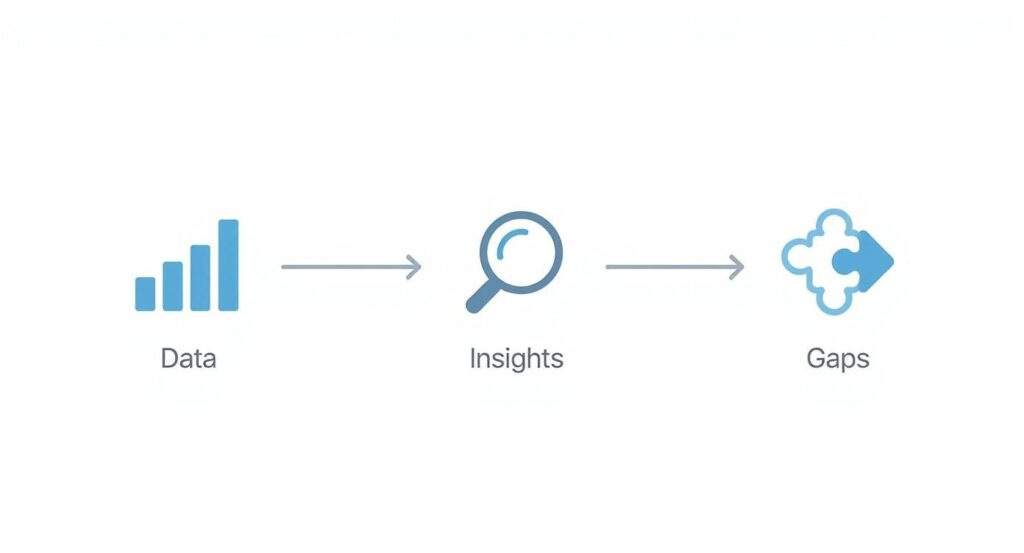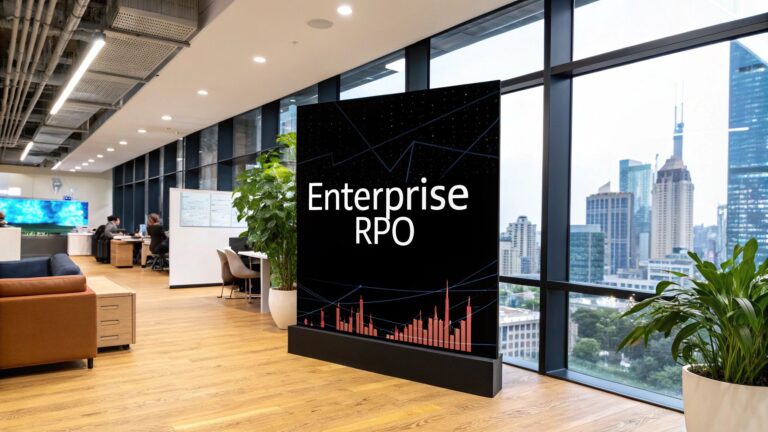A truly effective recruitment training program isn’t built on assumptions. It’s a strategic investment, grounded in a deep understanding of what your team actually needs to succeed. This means digging into performance data and gathering direct feedback to find the specific skill gaps that are holding you back. Get this right, and every training module you create will be relevant, impactful, and drive better hiring outcomes.
Building Your Program on a Solid Foundation
Trying to design a recruitment training program without a thorough needs analysis is like building a house without a blueprint. It might look okay from the outside, but it won’t stand up to real-world pressures or perform when it matters most. So, the first and most critical phase is to move beyond guesswork and anchor your program in solid data and real human insights.
This foundational work ensures your training budget is spent solving actual problems and developing the precise skills your team needs to excel. It elevates the program from a simple administrative task to a powerful driver of key business objectives.
Start with the Hard Numbers
Your journey begins with the data you already have. Your Applicant Tracking System (ATS) and HR dashboards are goldmines of information, full of patterns that can point you toward areas for improvement. Don’t just skim the surface-level metrics; dig deeper to uncover the story behind the numbers.
Here are a few key metrics to get you started:
- Time-to-Fill: If certain roles are consistently taking ages to fill, it could signal weak sourcing skills for that specialisation or an inefficient screening process bogging things down.
- Quality-of-Hire: Look at the performance reviews of new hires after six to twelve months. If the scores are low, you can often trace it back to weaknesses in behavioural interviewing or how candidates were assessed.
- Offer Acceptance Rates: Are your top candidates frequently saying “no thanks”? This could point to a need for training in negotiation, managing the candidate experience, or better articulating your company’s value proposition.
- Source-of-Hire: Analysing which channels bring in your best people helps you see if the team needs training on underutilised platforms or more advanced sourcing techniques. For more on this, check out how recruitment process outsourcing can help in high-impact hiring driven by data.
This flow shows how you can turn raw data into actionable insights to pinpoint those critical skill gaps.

As you can see, a successful needs analysis moves methodically from collecting performance metrics to identifying the specific training interventions required.
Gather the Human Insights
Data tells you what is happening, but conversations with your team will tell you why. Qualitative feedback provides the rich context and nuance that numbers alone can’t capture. The key is to create a safe environment where your recruiters feel comfortable sharing their real challenges and aspirations.
Consider running structured interviews or focus groups. A great approach is to segment your team. Talk to your top performers to decode what makes them so successful—their habits can become the best practices you teach everyone else. At the same time, sit down with your newest recruiters to understand the biggest hurdles they face in their first few months.
The goal is to build a 360-degree view of your team’s capabilities. Combining hard data with human insights allows you to identify the precise competencies that will drive the most significant improvements in your hiring outcomes.
This combined approach stops you from creating a generic, one-size-fits-all recruitment training program. Instead, you’ll build a targeted solution that solves the real-world challenges your team faces every single day, from managing tricky stakeholders to mastering niche sourcing tools.
Designing a Curriculum for High-Performing Recruiters

With your needs analysis complete, you’ve got a clear picture of your team’s skill gaps. Now comes the exciting part: building a curriculum that turns those gaps into strengths.
A world-class recruitment training program isn’t just a list of topics. It’s a carefully crafted learning path designed to elevate good recruiters into indispensable talent advisors. The goal is to blend essential, foundational skills with the advanced, strategic thinking required to win in today’s cutthroat talent market.
Laying the Groundwork with Core Modules
No matter how seasoned they are, every recruiter benefits from a strong command of the fundamentals. These core modules are the foundation of your entire program, creating a consistent, high-quality baseline for everyone. It’s about establishing a shared language and a unified process.
Think of these as the absolute non-negotiables:
- Mastering the Recruitment Lifecycle: This is where you map out the entire journey, from taking a rock-solid brief from a hiring manager to closing the offer and kicking off onboarding. It’s vital to show how a sharp, detailed intake meeting directly influences the quality of candidates you find later on. For more on this, our guide on recruitment steps for a smooth hiring ramp-up is a great resource.
- Strategic Candidate Sourcing: It’s time to move beyond the job boards. This module needs to get into the weeds of advanced Boolean searches, sourcing on specialised platforms like GitHub or Behance, and the art of building proactive talent pipelines. Give your team a real “purple squirrel” role to source for—the hands-on practice is invaluable.
- Behavioural and Structured Interviewing: Your team needs the tools to conduct interviews that actually predict job performance. This means diving deep into competency-based questions, mastering the STAR (Situation, Task, Action, Result) method, and, crucially, learning to spot and mitigate unconscious bias.
One of the most effective ways to teach this is through role-playing. Have your recruiters interview a trained “candidate” who throws them curveballs like vague answers or tough questions about company culture. It builds confidence and skill in a safe environment.
Integrating Advanced and Specialised Topics
To truly transform your recruiters into strategic partners, you need to go beyond the basics. This is where advanced modules come in, tackling the complex, nuanced challenges of modern talent acquisition.
These topics are what will give your team—and your business—a real competitive edge.
Building a curriculum isn’t just about teaching recruiters how to fill roles. It’s about empowering them to become market experts, brand ambassadors, and trusted advisors who can influence hiring decisions and drive business outcomes.
Consider adding these game-changing subjects to your agenda:
- Diversity, Equity, and Inclusion (DEI) in Sourcing: This isn’t an add-on; it’s a core competency. This module must provide concrete, actionable strategies for writing inclusive job descriptions, actively sourcing from underrepresented communities, and ensuring the entire process is equitable for every single candidate.
- Technology Enablement: A modern recruiter is only as good as their tech stack. A dedicated module should cover how to get the most out of your Applicant Tracking System (ATS), use AI-sourcing tools effectively, and interpret analytics to make smarter, data-backed decisions.
- Developing Influencing and Negotiation Skills: Finding top talent is only half the battle; closing them is the other. This module hones the soft skills that make all the difference—influencing hesitant hiring managers, managing stakeholder expectations, and negotiating complex offers to secure a 90% or higher acceptance rate.
Here’s a breakdown of what a well-rounded curriculum could look like:
Core Modules for a Modern Recruitment Training Program
A comprehensive curriculum should cover the entire talent acquisition lifecycle, from foundational skills to advanced strategies. The table below outlines essential modules, their specific topics, and what recruiters should be able to do after completing them.
| Module Category | Specific Topics Covered | Primary Learning Objective |
|---|---|---|
| Recruitment Fundamentals | Full lifecycle overview, intake meetings, stakeholder management | Establish a consistent, best-practice process across the team |
| Sourcing & Talent Attraction | Advanced Boolean, social sourcing, employer branding, talent pipelining | Proactively find and engage top-tier passive candidates |
| Interviewing & Assessment | Behavioural interviews, STAR method, bias reduction, technical screens | Conduct fair and predictive interviews that identify the best fit |
| Offer Management & Closing | Negotiation tactics, compensation benchmarking, selling the opportunity | Secure top candidates with a high offer acceptance rate |
| Technology & Analytics | ATS optimisation, AI sourcing tools, recruitment marketing platforms | Use technology to improve efficiency and make data-driven decisions |
| Strategic Competencies | DEI sourcing, talent market intelligence, consultative skills | Evolve from a recruiter to a strategic talent advisor to the business |
This structure ensures that every recruiter, regardless of their starting point, develops the skills needed not just to fill roles today, but to anticipate and meet the talent needs of tomorrow.
To make these advanced topics stick, use real-world case studies from your own company’s history. Present a hiring challenge you faced in the past and have the team workshop a solution using the new techniques they’ve just learned. This hands-on application is what transforms your recruitment training program from a theoretical exercise into a real engine for business growth.
Choosing Delivery Methods for Maximum Engagement

Even the most brilliant curriculum can fall flat if it’s delivered poorly. Let’s be honest, in the high-pressure world of recruiting, how you deliver training is just as important as what you’re teaching. The days of a one-size-fits-all, week-long workshop are over. The real key is building a blended learning experience that respects your team’s time and caters to different learning styles.
This isn’t about just picking between “online” or “in-person.” The most effective recruitment training program is one that strategically weaves together different delivery methods, playing to the strengths of each. This approach drives up engagement, makes knowledge stick, and ensures new skills are actually put into practice.
Crafting a Blended Learning Strategy
A blended model isn’t just a random mix of formats; it’s about creating a thoughtful, integrated learning journey. Each piece should build on the last, matching the delivery method to the complexity of the skill being taught. This gives busy recruiters much-needed flexibility while saving the high-touch, collaborative sessions for when they’ll have the most impact.
Think about it like this:
- Self-Paced E-Learning for Foundations: This is perfect for the core, evergreen knowledge. Things like compliance training, the ins-and-outs of internal hiring policies, or a basic tutorial on your Applicant Tracking System (ATS) are ideal for on-demand modules. Recruiters can learn at their own pace and revisit the material whenever they need a refresher.
- Virtual Instructor-Led Training (VILT) for Skill Building: Live virtual sessions are fantastic for interactive skill development. A trainer can run a session on advanced Boolean search strings, demonstrating techniques live and fielding questions in real-time. You can use breakout rooms for small group work, like having peers critique each other’s candidate outreach emails.
- In-Person Workshops for Complex Interactions: Save your valuable face-to-face time for the most nuanced, high-stakes skills. There’s simply no substitute for being in the room when you’re role-playing a tricky offer negotiation or practising tough conversations with hiring managers. It allows trainers to pick up on body language and give immediate, detailed feedback.
A Real-World Blended Program Example
Let’s say you’re rolling out a new module on improving candidate engagement. Instead of pulling everyone off their desks for a full day, you could structure it like this:
- Pre-Work (E-Learning): First, recruiters complete a 45-minute self-paced module on the fundamentals of candidate experience and communication best practices, delivered through your Learning Management System (LMS).
- Interactive Practice (VILT): Next, the whole team joins a 90-minute live virtual session. The facilitator can lead a discussion on real-world challenges before using breakout rooms to have recruiters workshop and polish their communication templates together.
- Application and Strategy (In-Person): Finally, during the next quarterly team offsite, you dedicate a two-hour workshop to role-playing difficult candidate scenarios—like rescinding an offer or navigating mismatched salary expectations.
This tiered approach ensures the foundational knowledge is covered efficiently, practical skills are developed interactively, and the complex human elements are mastered in a supportive, live setting. It makes the entire learning process feel more manageable and directly tied to their day-to-day work.
The ultimate goal is to design a learning ecosystem, not just a series of events. By blending self-paced, virtual, and in-person training, you create a flexible and powerful recruitment training program that meets recruiters where they are and equips them for success.
This method shows respect for your team’s demanding schedules. It empowers them to own their foundational learning while guaranteeing they get expert guidance and collaborative practice for the skills that truly separate a good recruiter from a great one. The result? A more engaged team that can immediately apply what they’ve learned to attract and hire top talent more effectively.
Measuring Success and Proving the ROI of Your Program
Any recruitment training programme is a significant investment of both time and money. That’s why proving its value isn’t just a nice-to-have—it’s absolutely essential for securing future budgets and showing the business the real strategic impact of your talent acquisition team.
The goal here is to draw a clear, direct line from the new skills your team learns to measurable improvements in hiring speed, quality, and ultimately, business performance. It’s about moving beyond superficial stats like course completion rates to focus on tangible outcomes that matter. Setting these key performance indicators (KPIs) right from the start is the key to building a powerful business case.
Moving Beyond Vanity Metrics to Business Impact
To truly know if the programme worked, you need to define what success looks like before you even begin. The most powerful way to do this is to benchmark your current performance on a few critical KPIs. Then, track those same metrics again three to six months after the training is complete. This simple before-and-after picture provides undeniable proof of the programme’s impact.
These are the core metrics that tell the real story:
- Time-to-Fill: This is one of the clearest indicators of better efficiency. A drop in the average number of days it takes to fill a role proves your recruiters are sourcing, screening, and moving candidates through the pipeline much faster.
- Quality-of-Hire: This is the gold standard. Look at the performance ratings of new hires after their first six or twelve months on the job. An uptick in these scores is powerful evidence that your team is making smarter, more predictive hiring decisions.
- Offer Acceptance Rate: A higher acceptance rate shows your recruiters have sharpened their skills in selling the opportunity, managing candidate expectations, and negotiating effectively. This metric directly means less wasted time and fewer top candidates slipping away.
Consistent tracking is vital. Just look at OYO Rooms—they discovered that focusing on specific hiring metrics can lead to massive improvements, showing how targeted training efforts pay off. You can see how OYO Rooms experienced a big lift in their hiring metrics in our detailed case study.
Quantifying the Return on Investment
Calculating the ROI of your training programme puts its value into the language the C-suite understands best: money. It might sound complicated, but a simple calculation can clearly show the programme’s financial contribution.
One straightforward approach is to calculate the value of increased efficiency. For instance, let’s say your training programme cuts the average time-to-fill by five days across 100 hires. If you estimate the average daily cost of a vacancy is ₹5,000, the savings add up quickly.
Calculation Example: 5 days saved per hire x 100 hires = 500 days saved 500 days x ₹5,000 cost per day = ₹2,500,000 in productivity savings This simple figure makes a powerful statement about the programme’s direct financial benefit.
Don’t Forget the People Metrics
While hard numbers and operational KPIs are critical, don’t overlook the impact on your team itself. A great training programme is a direct investment in your people, and you’ll see the results in their engagement and loyalty.
Make sure to track these important people-focused metrics too:
- Recruiter Engagement Scores: Use pulse surveys before and after the training to measure shifts in job satisfaction, confidence, and motivation.
- Recruiter Retention: A lower turnover rate within your talent acquisition team is a strong sign of a positive, supportive work environment. It also creates huge cost savings related to replacing and onboarding new team members.
This intense focus on upskilling aligns perfectly with what’s happening in the broader market. India’s vocational training market, valued at USD 1,289.2 million in 2024, is poised for major growth, reflecting a nationwide push for industry-specific skills. This trend highlights just how important structured training is for preparing professionals for today’s business challenges.
By blending hard operational data with these softer people metrics, you can paint a complete and compelling picture of your programme’s success. You’ll prove it’s not a cost centre, but a true engine for organisational growth.
Rolling Out the Programme and Driving Team Adoption

You can have the most perfectly designed recruitment training programme on paper, but if the launch is fumbled, it’s all for nothing. That moment of transition from design to delivery is make-or-break. It requires a thoughtful strategy, not just a calendar invite blasted out to the team.
A seamless rollout is about building momentum, managing the inevitable change, and making sure your team feels invested in the process. You want them to see this as an opportunity, not just another mandatory meeting. This is your chance to frame the training as a genuine investment in their careers, securing buy-in from both your recruiters and the hiring managers they work with every day.
Build Excitement with a Strategic Communication Plan
Your communication needs to start long before the first training session is even scheduled. The goal here is simple: build genuine excitement and answer the one question every recruiter is asking: “What’s in it for me?”
Don’t just rely on a single, generic email announcement. Think bigger. Create a multi-channel campaign to get people talking.
Here’s a practical way to approach it:
- Get an Executive Endorsement: Kick things off with a message from a senior leader, maybe the CHRO or Head of Talent. Have them explain the why behind the programme and its strategic importance. This simple act immediately signals that this is a priority.
- Highlight the “WIIFM”: In every piece of communication, hammer home the benefits for the recruiters. Talk about how it will help them hit their targets faster, earn more commission, or finally become the trusted advisors they want to be.
- Bring Hiring Managers into the Fold: Don’t forget this critical group. Let hiring managers know how an upskilled recruiting team will deliver better candidates and a smoother process for them. When they’re on board, they become powerful advocates.
The Power of a Pilot Programme
Before you go big and roll out the recruitment training programme to the entire organisation, it’s incredibly wise to run a small-scale pilot. This isn’t about adding red tape; it’s a vital stress test.
Running a pilot with a select group—ideally a mix of new hires and seasoned veterans—gives you invaluable, honest feedback. They’ll tell you what’s working and what isn’t, from the relevance of the content to the pacing of the modules. Their insights allow you to make those small, critical tweaks that can dramatically improve the experience for everyone else.
Think of the pilot as a dress rehearsal. It lets you refine your content, test your tech, and, most importantly, create a group of internal champions. These early adopters can then share their positive experiences, creating authentic buzz for the full launch.
Managing Change and Integrating Partners
Even with the best communication, some people will resist change. You might have tenured recruiters who feel they already know it all. The best way to handle this is to address it head-on. Involve them in the process. Ask them to serve as mentors for newer team members or to share their expertise during specific sessions.
This is also the perfect moment to align with external partners, like your Recruitment Process Outsourcing (RPO) provider. Bringing their teams into the rollout from day one ensures consistency across your entire talent acquisition function.
When your RPO partner’s recruiters are trained on your specific methodologies and culture, they stop being just a vendor and become a true extension of your team. This alignment is what turns a good talent function into a high-performing hiring machine.
Looking at the bigger picture, it’s helpful to see how these initiatives fit into national trends. In India, for example, apprenticeship programmes are becoming a cornerstone of workforce development. For 2025, major companies are offering extensive courses in key sectors like IT and manufacturing, proving the value of structured, hands-on learning. You can explore a variety of top apprenticeship programmes in India to see how the industry is evolving. This national focus reinforces just how important it is to keep investing in your team’s growth.
Ready to build a world-class talent acquisition function without the operational overhead? Taggd specialises in creating and scaling high-performing recruiting teams through our expert RPO solutions. Let us help you integrate a powerful recruitment training programme that drives measurable results.








